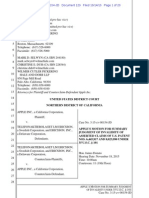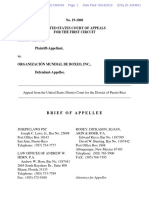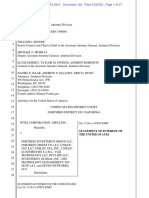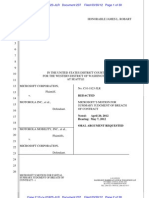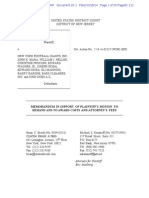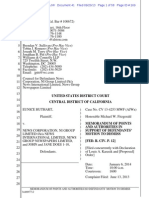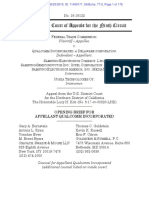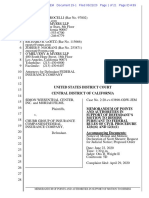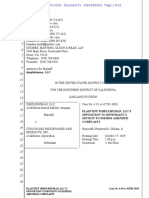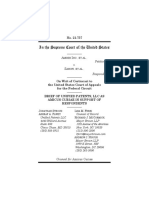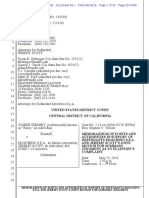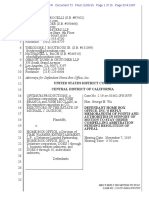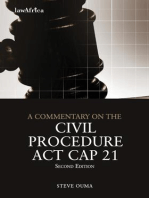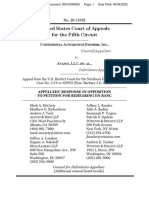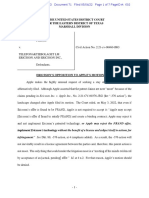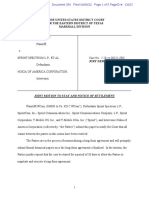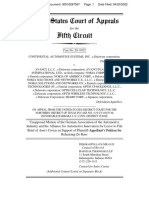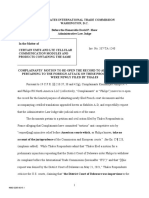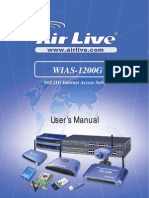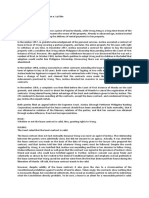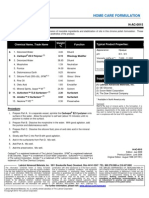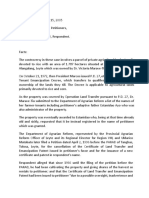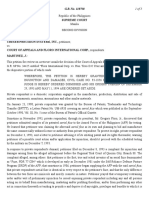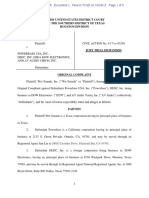Professional Documents
Culture Documents
11-07-01 Apple Motion For PI Against Samsung
Uploaded by
Florian MuellerOriginal Title
Copyright
Available Formats
Share this document
Did you find this document useful?
Is this content inappropriate?
Report this DocumentCopyright:
Available Formats
11-07-01 Apple Motion For PI Against Samsung
Uploaded by
Florian MuellerCopyright:
Available Formats
Case5:11-cv-01846-LHK Document86
Filed07/01/11 Page1 of 37
1 2 3 4 5 6 7 8 9 10 11 12 13 14 15 16 17 18 19 20 21 22
HAROLD J. MCELHINNY (CA SBN 66781) hmcelhinny@mofo.com MICHAEL A. JACOBS (CA SBN 111664) mjacobs@mofo.com JENNIFER LEE TAYLOR (CA SBN 161368) jtaylor@mofo.com ALISON M. TUCHER (CA SBN 171363) atucher@mofo.com RICHARD S.J. HUNG (CA SBN 197425) rhung@mofo.com JASON R. BARTLETT (CA SBN 214530) jasonbartlett@mofo.com MORRISON & FOERSTER LLP 425 Market Street San Francisco, California 94105-2482 Telephone: (415) 268-7000 Facsimile: (415) 268-7522 Attorneys for Plaintiff APPLE INC.
KENNETH H. BRIDGES (CA SBN 243541) kbridges@bridgesmav.com MICHAEL T. PIEJA (CA SBN 250351) mpieja@bridgesmav.com BRIDGES & MAVRAKAKIS LLP 3000 El Camino Real One Palo Alto Square, 2nd Floor Palo Alto, CA 94306 Telephone: (650) 804-7800 Facsimile: (650) 852-9224
UNITED STATES DISTRICT COURT NORTHERN DISTRICT OF CALIFORNIA SAN JOSE DIVISION
APPLE INC., a California corporation, Plaintiff, v. SAMSUNG ELECTRONICS CO., LTD., a Korean corporation; SAMSUNG ELECTRONICS AMERICA, INC., a New York corporation; and SAMSUNG TELECOMMUNICATIONS AMERICA, LLC, a Delaware limited liability company, Defendants.
Case No. 11-cv-01846-LHK APPLE INC.S MOTION FOR A PRELIMINARY INJUNCTION Date: Time: Place: Judge: August 5, 2011 1:30 p.m. Courtroom 4, 5th Floor Hon. Lucy H. Koh
23 24 25 26 27 28
APPLES MOTION FOR A PRELIMINARY INJUNCTION CASE NO. 11-CV-01846-LHK sf-3006623
Case5:11-cv-01846-LHK Document86
Filed07/01/11 Page2 of 37
1 2 3 4 5 6 7 8 9 10 11 12 13 14 15 16 17 18 19 20 21 22 23 24 25 26 27 28
TO DEFENDANTS AND THEIR ATTORNEYS OF RECORD: PLEASE TAKE NOTICE that on August 5, 2011 at 1:30 p.m., or as soon thereafter as the matter may be heard, in the courtroom of the Honorable Lucy H. Koh at the United States District Court for the Northern District of California, 280 South 1st Street, Courtroom 4, 5th Floor, San Jose, Plaintiff Apple Inc. shall and hereby does move the Court for a preliminary injunction prohibiting Defendants Samsung Electronics Co., Ltd., Samsung Electronics America, Inc., and Samsung Telecommunications America, Inc. (collectively Samsung or Defendants), from making, using, offering to sell, or selling within the United States, or importing into the United States, the following recently released products: the Galaxy S 4G, Infuse 4G, and Droid Charge smartphones, and the Galaxy Tab 10.1 tablet computer. This motion is based on this notice of motion and supporting memorandum of points and authorities; the supporting declarations and exhibits of Cooper C. Woodring, Ravin Balakrishnan, Patrick J. Zhang, Jason R. Bartlett, Richard J. Lutton, Jr., and Sissie Twiggs; and such other written or oral argument as may be presented at or before the time this motion is taken under submission by the Court.
Dated: July 1, 2011
HAROLD J. MCELHINNY MICHAEL A. JACOBS JENNIFER LEE TAYLOR ALISON M. TUCHER RICHARD S.J. HUNG JASON R. BARTLETT MORRISON & FOERSTER LLP
By:
/s/ Michael A. Jacobs MICHAEL A. JACOBS Attorneys for Plaintiff APPLE INC.
APPLES MOTION FOR A PRELIMINARY INJUNCTION CASE NO. 11-CV-01846-LHK sf- 3006623
Case5:11-cv-01846-LHK Document86
Filed07/01/11 Page3 of 37
1 2 3 4 5 6 7 8 9 10 11 12 13 14 15 B. 16 17 18 19 20 21 22 23 24 25 26 27 28 V. VI. VII. IV. III. B. 3.
TABLE OF CONTENTS Page INTRODUCTION .......................................................................................................................... 1 ARGUMENT .................................................................................................................................. 5 I. II. PRELIMINARY INJUNCTION STANDARD.................................................................. 5 APPLE IS LIKELY TO SUCCEED ON THE MERITS OF ITS CLAIM FOR DESIGN PATENT INFRINGEMENT ...................................................................... 5 A. Apple Is Likely to Prove Design Patent Infringement at Trial ............................... 6 1. 2. The Samsung Infuse 4G and Galaxy S 4G Phones Infringe the D677 Patent.......................................................................................... 7 The Samsung Infuse 4G and Galaxy S 4G Phones Infringe the D087 Patent........................................................................................ 11 Samsungs Galaxy Tab 10.1 Infringes the D889 Patent.......................... 13
Apple is Likely to Prevail on Design Patent Validity at Trial .............................. 16
APPLE IS ENTITLED TO A PRELIMINARY INJUNCTION BASED ON SAMSUNGS INFRINGEMENT OF THE 381 PATENT ...................................... 17 A. The 381 Patent Has Survived Reexamination and Does Not Present Any Claim Terms Requiring Construction ........................................................... 17 Apple Is Likely to Succeed on the Merits............................................................. 18 1. 2. Samsung Infringes the Claims of the 381 Patent..................................... 18 Samsung Is Unlikely to Prevail on Invalidity at Trial............................... 23
A PRELIMINARY INJUNCTION IS NECESSARY TO PREVENT IRREPARABLE HARM .................................................................................................. 24 A. B. Apple Will Be Irreparably Harmed if Samsung Continues to Erode the Distinctiveness of Apples Designs and to Take Market Share ...................... 24 Because Apple Is Seeking a Preliminary Injunction Against Samsungs Newly Released Products, Its Alleged Delays in Enforcing Its Rights Are Irrelevant....................................................................... 27
THE BALANCE OF EQUITIES WEIGHS DECIDEDLY IN APPLES FAVOR ............................................................................................................................. 29 A PRELIMINARY INJUNCTION SERVES THE PUBLIC INTEREST ....................... 30 CONCLUSION ................................................................................................................. 30
APPLES MOTION FOR A PRELIMINARY INJUNCTION CASE NO. 11-CV-01846-LHK sf- 3006623
ii
Case5:11-cv-01846-LHK Document86
Filed07/01/11 Page4 of 37
1 2 3 4 5 6 7 8 9 10 11 12 13 14 15 16 17 18 19 20 21 22 23 24 25 26 27 28 CASES
TABLE OF AUTHORITIES Page(s) Abbott Labs. v. Sandoz, Inc., 544 F.3d 1341 (Fed. Cir. 2008)........................................................................................... 5, 24 Amini Innovation Corp. v. Anthony California, Inc., 439 F.3d 1365 (Fed. Cir. 2006)................................................................................................. 6 Apple Inc. v. Brilliant Store, Inc., 10-cv-2996-SBA, slip. op. (N.D. Cal. Jan. 5, 2011) ............................................................... 16 AstraZeneca LP v. Apotex Corp., 633 F.3d 1042 (Fed. Cir. 2010)..................................................................................... 5, 18, 24 Blumenthal Distrib. v. Exec. Chair, Inc., No. 10-CV-1280, 2011 U.S. Dist. LEXIS 28203 (E.D.N.Y. Mar. 3, 2011) ............................. 5 Brown v. 3M, 265 F.3d 1349 (Fed. Cir. 2001)............................................................................................... 18 Egyptian Goddess, Inc. v. Swisa, Inc., 543 F.3d 665 (Fed. Cir. 2008).......................................................................................... passim Elantech Devices Corp. v. Synaptics, Inc., C06cv1839 CRB, 2008 U.S. Dist. LEXIS 120024 (N.D. Cal. Mar. 13, 2008)....................... 28 Fred Hutchinson Cancer Research Ctr. v. BioPet Vet Lab, Inc., 10-cv-616, 2011 WL 1119563 (E.D. Va. Mar. 17, 2011)................................................. 29, 30 Gorham Mfg. Co. v. White, 81 U.S. 511 (1872) .................................................................................................................... 7 Hoop v. Hoop, 279 F.3d 1004 (Fed. Cir. 2002)............................................................................................. 5, 6 Intl Seaway Trading Corp. v. Walgreens Corp., 589 F.3d 1234 (Fed. Cir. 2009)..................................................................................... 6, 10, 13 iRise v. Axure Software Solutions, Inc., No. CV 08-3601-SJO, 2009 WL 3615075 (C.D. Cal. Sept. 11, 2009)................................... 23 L.A. Gear, Inc. v. Thom McAn Shoe Co., 988 F.2d 1117 (Fed. Cir. 1993)........................................................................................... 9, 12 Microsoft Corp. v. i4i Ltd. Pshp, 564 U.S. --, 180 L. Ed. 131 (2011) ......................................................................................... 16
APPLES MOTION FOR A PRELIMINARY INJUNCTION CASE NO. 11-CV-01846-LHK sf- 3006623
iii
Case5:11-cv-01846-LHK Document86
Filed07/01/11 Page5 of 37
1 2 3 4 5 6 7 8 9 10 11 12 13 14 15 16 17 18 19 20 21 22 23 24 25 26 27 28
Nanoexa Corp. v. Univ. of Chicago, No. 10-CV-2631-LHK, 2010 WL 3398532 (N.D. Cal. Aug. 27, 2010) ................................. 24 Nokia Corp. v. Apple Inc., Case No. 1:09cv791 (D. Del.) (the Nokia Action) ........................................................ 17, 18 Oakley, Inc. v. Sunglass Hut Intl, No. SA CV 01-1065-AHS, 2001 WL 1683252 (C.D. Cal. Dec. 7, 2001), affd, 316 F.3d 1331, 1339 (Fed. Cir. 2003); .......................................................................... 23 Oscar Mayer Foods Corp. v. Sara Lee Corp., No. 90-D-42-C, 1990 U.S. Dist. LEXIS 10032 (W.D. Wis. Mar. 20, 1990).......................... 24 Payless Shoesource, Inc. v. Reebok Int'l, Ltd., 998 F.2d 985 (Fed. Cir. 1993)................................................................................................... 7 Procter & Gamble Co. v. Kraft Foods Global, Inc., 549 F.3d 842 (Fed. Cir. 2008)................................................................................................. 23 Reebok Intl Ltd. v. J. Baker, Inc., 32 F.3d 1552 (Fed. Cir. 1994)................................................................................................. 24 Rexnord, Inc. v. Laitram Corp., 1 U.S.P.Q.2d 1923 (E.D. Wis. 1986) ................................................................................ 28, 29 Telebrands Direct Response Corp. v. Ovation Commcns, Inc., 802 F. Supp. 1169 (D.N.J. 1992) ................................................................................ 24, 29, 30 Titan Tire Corp. v. Case New Holland, Inc., 566 F.3d 1372 (Fed. Cir. 2009)..................................................................................... 5, 16, 23 Trak, Inc. v. Benner Ski KG, 475 F. Supp. 1076 (D. Mass. 1979) ........................................................................................ 30 U.S. Surgical Corp. v. Ethicon, Inc., 103 F.3d 1554 (Fed. Cir. 1997)............................................................................................... 18 Whistler Corp. v. Dynascan Corp., 9 U.S.P.Q.2d 2087 (N.D. Ill. 1988)................................................................................... 28, 29
APPLES MOTION FOR A PRELIMINARY INJUNCTION CASE NO. 11-CV-01846-LHK sf- 3006623
iv
Case5:11-cv-01846-LHK Document86
Filed07/01/11 Page6 of 37
1 2 3 4 5 6 7 8 9 10 11 12 13 14 15 16 17 18 19 20 21 22 23 24 25 26 27 28
MEMORANDUM OF POINTS AND AUTHORITIES Apple moves for a preliminary injunction to prevent Defendants from infringing three Apple design patents and one utility patent by selling four recently released products: the Infuse 4G, Galaxy S 4G, and Droid Charge smartphones, and the Galaxy Tab 10.1 tablet computer. INTRODUCTION Apples iPhone and iPad mobile devices are among the most distinctive and commercially successful products in the world. The success of these products is no accident. It was earned through Apples substantial investment in design innovation, product development, and worldwide marketing and advertising. Apples Amended Complaint explains the significance of Apples elegant and distinctive product designs. The unique and refined Apple look of Apples iPhone and iPad products has become recognizable around the globe and has played a critical role in their extraordinary commercial success. The look and operation of the Samsung smartphones and tablet computer that are the subject of this motion are likewise no accident. As described in the Amended Complaint, Samsung chose to copy Apple, not to innovate. The message that Samsung conveys to consumers with its imitative smartphone design is simple: Its just like an iPhone. Samsungs Galaxy Tab 10.1 tablet sends a similar message: Its just like an iPad. With the benefit of those messages, Samsung is seeking to take market share by trading off of the popularity of Apples products. When Apple became aware of Samsungs copying, it attempted to persuade Samsung to stop. Those pleas fell on deaf ears. Samsungs recent products confirm that Samsung is continuing its deliberate policy of releasing products in the United States that mimic Apples iPhone and iPad products. The similarity is unmistakable:
APPLES MOTION FOR A PRELIMINARY INJUNCTION CASE NO. 11-CV-01846-LHK sf- 3006623
Case5:11-cv-01846-LHK Document86
Filed07/01/11 Page7 of 37
1 2 3 4 5 6 7 8 9 10 11 12 13 14 15 16 17 18 19 20 21 22 23 24 25 26 27 28
APPLES PRODUCTS1
SAMSUNGS PRODUCTS2
iPhone 3GS Released June 2009
Galaxy S 4G Released February 2011
iPhone 4 Released June 2010
1
Infuse 4G Released May 2011
The iPhone 3GS was released in June 2009, the iPhone 4 was released in June 2010, and the iPad 2 was released in March 2011. (See Declaration of Patrick J. Zhang in Support of Apples Motion for Preliminary Injunction (Zhang Decl.), Exs. 23-26.) 2 The Samsung Galaxy S 4G was released in February 2011, the Infuse 4G was released in May 2011, and the Tab 10.1 was released in June 2011. (See Zhang Decl. Exs. 33-37.)
APPLES MOTION FOR A PRELIMINARY INJUNCTION CASE NO. 11-CV-01846-LHK sf- 3006623
Case5:11-cv-01846-LHK Document86
Filed07/01/11 Page8 of 37
1 2 3 4 5 6 7 8 9 10 11 12 13 14 15 16 17 18 19 20 21 22 23 24 25 26 27 28 In article after article, the media has reported on the striking similarity of Samsungs phones and tablets to Apples iPhone and iPad. (See Zhang Decl. 2-5 and Exs. 1-4.) Samsung has been copying competitors for years. (See id. at 6-7 and Exs. 5-6.) Samsungs conduct makes clear that it has adopted cloning as its business strategy for the mobile device field. Apples substantial investment in product design and function is protected by a range of intellectual property rights. Apples Amended Complaint asserts seven design patents and eight utility patents against Samsung products, as well as Apples trademark and trade dress rights. Apple brings this preliminary injunction motion because Samsungs latest product releases show that Samsung is ramping up a massive assault on Apples market and is doing so with products that blatantly infringe Apples intellectual property rights. Preventing that assault from irreparably harming Apple is a matter of the utmost urgency. In order to expedite resolution of this motion, Apple has selected intellectual property rights that lend themselves readily to adjudication without trial. To protect its iconic product designs, Apple demonstrates in this motion that Samsungs products infringe Apples iPhone and
APPLES MOTION FOR A PRELIMINARY INJUNCTION CASE NO. 11-CV-01846-LHK sf- 3006623
iPad 2 Released March 2011
Galaxy Tab 10.1 Released June 2011 (with promise of new user interface in future update)
Case5:11-cv-01846-LHK Document86
Filed07/01/11 Page9 of 37
1 2 3 4 5 6 7 8 9 10 11 12 13 14 15 16 17 18 19 20 21 22 23 24 25 26 27 28
iPad Design Patent Nos. D618,677 (the D677 patent), D593,087 (the D087 patent), and D504,889 (the D889 patent). Deciding infringement of these design patents is as simple as comparing Apples design patents to images of the Samsung products and observing the substantial similarity between the two. The same is true for validity: a visual comparison of prior art designs with Apples design patents confirms that Apples patented designs are radically different from the prior art. To protect its pioneering advances in user interface functionality, Apple demonstrates in this motion that the Samsung products infringe U.S. Patent No. 7,469,381 (the 381 patent). The 381 patent is a strong, easily understood patent. It is directed to a clever method for displaying images on touch screens: when one uses a finger to drag a displayed page past its bottom edge, for example, and releases the finger, the page bounces back to fill the full screen. The claims of the 381 patent are so clear that in recent litigation between Apple and Nokia Corporation, neither side asked the court to construe any terms. A simple demonstration proves that Samsungs products infringe. Moreover, the Patent Office confirmed the validity of all twenty claims of this patent in a reexamination initiated by Nokia, which included the best prior art references Nokia could find. For even greater simplicity, Apple is limiting this motion to new products that Samsung recently released in the U.S. Apple has not targeted the unreleased Galaxy S 2 phone and Galaxy Tab 8.9 tablet computer. Apple reserves the right to seek a preliminary injunction against those two products as their release becomes imminent. While Apples other claims are equally strong, they potentially raise additional issues that could delay the prompt issuance of a preliminary injunction. But the urgency of resolving all of Apples claims remains. Accordingly, Apple is filing a concurrent motion for an expedited trial on all of its claims. It is hard to imagine a more compelling case for issuing a preliminary injunction. Samsungs copying is blatant. Apples innovations are renowned, and are the result of substantial investment in research and development. Apple is likely to prevail on the merits of the design and utility patent claims presented in this motion. Unless enjoined, Samsungs sales of a new
APPLES MOTION FOR A PRELIMINARY INJUNCTION CASE NO. 11-CV-01846-LHK sf- 3006623
Case5:11-cv-01846-LHK Document86
Filed07/01/11 Page10 of 37
1 2 3 4 5 6 7 8 9 10 11 12 13 14 15 16 17 18 19 20 21 22 23 24 25 26 27 28
round of copycat products will cause irreparable harm to Apple that cannot be adequately compensated by damages. Accordingly, Apple requests that the Court issue a preliminary injunction and ensure that innovation not unlawful imitation is protected. ARGUMENT I. PRELIMINARY INJUNCTION STANDARD A plaintiff seeking a preliminary injunction must establish that [it] is likely to succeed on the merits, that [it] is likely to suffer irreparable harm in the absence of preliminary relief, that the balance of equities tips in [its] favor, and that an injunction is in the public interest. AstraZeneca LP v. Apotex Corp., 633 F.3d 1042, 1050 (Fed. Cir. 2010) (citing Winter v. Natural Res. Def. Council, Inc., 555 U.S. 7, 25 (2008).) When this standard is met, courts have issued preliminary injunctions prohibiting the sale of products in both utility and design patent cases. Id. at 1045 (affirming preliminary injunction against launch of generic drug in utility patent case); Abbott Labs. v. Sandoz, Inc., 544 F.3d 1341, 1343 (Fed. Cir. 2008) (affirming preliminary injunction in utility patent case); Hoop v. Hoop, 279 F.3d 1004, 1008 (Fed. Cir. 2002) (affirming preliminary injunction against sale of products likely to infringe design patent); Blumenthal Distrib. v. Exec. Chair, Inc., No. 10-CV-1280, 2011 U.S. Dist. LEXIS 28203, at *5 (E.D.N.Y. Mar. 3, 2011) (granting preliminary injunction based on likely infringement of design patent). Apple has met this standard for each of the patents at issue in this motion. II. APPLE IS LIKELY TO SUCCEED ON THE MERITS OF ITS CLAIM FOR DESIGN PATENT INFRINGEMENT To establish a reasonable likelihood of success on a design patent, the patentee seeking a preliminary injunction in a patent infringement suit must show that it will likely prove infringement, and that it will likely withstand challenges, if any, to the validity of the patent. Titan Tire Corp. v. Case New Holland, Inc., 566 F.3d 1372, 1376 (Fed. Cir. 2009). Apple is likely to prevail on infringement and is also likely to withstand challenges to the validity of its D677, D087 and D889 design patents.
APPLES MOTION FOR A PRELIMINARY INJUNCTION CASE NO. 11-CV-01846-LHK sf- 3006623
Case5:11-cv-01846-LHK Document86
Filed07/01/11 Page11 of 37
1 2 3 4 5 6 7 8 9 10 11 12 13 14 15 16 17 18 19 20 21 22 23 24 25 26 27 28
A.
Apple Is Likely to Prove Design Patent Infringement at Trial
Apple is likely to prove at trial that Samsungs products infringe Apples patented designs. The Federal Circuit clarified the design patent infringement standard in its en banc decision in Egyptian Goddess, Inc. v. Swisa, Inc., 543 F.3d 665 (Fed. Cir. 2008). The central inquiry is whether an ordinary observer, who is familiar with the prior art, would find the overall appearance of the accused product to be substantially the same as the overall appearance of the patented design, or to embody the claimed design or any colorable imitation thereof.3 Id. at 677-78; see also Amini Innovation Corp. v. Anthony California, Inc., 439 F.3d 1365, 1372 (Fed. Cir. 2006) (court must analyz[e] the design as a whole and not mistakenly analyze[] each element separately). An infringing product need not be an exact copy of the patented design, and Samsung cannot escape infringement by introducing minor variations into otherwise copycat products. Egyptian Goddess, 543 F.3d at 670 ([T]he [infringing design and patented design] need not be the same to the eye of an expert, because if that were the test, [t]here never could be piracy of a patented design, for human ingenuity has never yet produced a design, in all its details, exactly like another, so like, that an expert could not distinguish them) (quoting Gorham, 81 U.S. at 527). [T]he mandated overall comparison is a comparison taking into account significant differences between the two designs, not minor or trivial differences that necessarily exist between any two designs that are not exact copies of one another. Intl Seaway Trading Corp. v. Walgreens Corp., 589 F.3d 1234, 1243 (Fed. Cir. 2009) (emphasis added). The critical issue is whether the effect of the whole design [is] substantially the same minor differences between a patent design and an accused articles design cannot, and shall not, prevent a finding of
Some decisions use substantially similar to describe the ordinary observer test. See, e.g., Hoop v. Hoop, 279 F.3d 1004, 1007 (Fed. Cir. 2002) (The ultimate test for design-patent inventorship, like the test for anticipation and infringement, is whether the second asserted invention is substantially similar to the first) (citing Gorham Mfg. Co. v. White, 81 U.S. 511, 528 (1872)).
APPLES MOTION FOR A PRELIMINARY INJUNCTION CASE NO. 11-CV-01846-LHK sf- 3006623
Case5:11-cv-01846-LHK Document86
Filed07/01/11 Page12 of 37
1 2 3 4 5 6 7 8 9 10 11 12 13 14 15 16 17 18 19 20 21 22 23 24 25 26 27 28
infringement. Payless Shoesource, Inc. v. Reebok Int'l, Ltd., 998 F.2d 985, 991 (Fed. Cir. 1993) (citations and internal quotes omitted).4 The hypothetical ordinary observer is deemed to be conversant with the prior art, which may be relevant to infringement. Egyptian Goddess, 543 F.3d at 678. For example, [w]hen the differences between the claimed and accused design are viewed in light of the prior art, the attention of the hypothetical ordinary observer will be drawn to those aspects of the claimed design that differ from the prior art. Id. at 676. If the accused design has copied a particular feature of the claimed design that departs conspicuously from the prior art, the accused design is naturally more likely to be regarded as deceptively similar to the claimed design, and thus infringing. Id. at 677. The accused infringer, not the patentee, bears the burden of pointing out prior art that it considers pertinent to the comparison between the claimed and accused designs, although the patentee is also free to make such comparisons. Id. at 678-79. Easing adjudication of design patents on a preliminary injunction motion, there is no need for the district court to attempt to provide a detailed verbal description of the claimed design, as is typically done in the case of utility patents. Id. at 679. For this reason, no formal claim construction is required. 1. The Samsung Infuse 4G and Galaxy S 4G Phones Infringe the D677 Patent
The D677 patent, attached as Zhang Decl. Ex. 48, is directed to the ornamental appearance of the Apple iPhones distinctive front facea design that is instantly recognizable as Apple and iPhone. As shown, Samsungs Galaxy S 4G and Infuse 4G phones copy Apples patented design and appear to the ordinary observer to be substantially the same.5 (See Woodring Decl., 13-27 and Exs. 8-13.)
In fact, in the Supreme Courts landmark Gorham case, the accused spoon had noticeable differences from the patented design. It was nevertheless held to infringe under the ordinary observer test based on overall impression. (See Declaration of Cooper C. Woodring (Woodring Decl.), filed herewith, 51-52 and Ex. 22 (Cooper C. Woodring, One Mans Crusade: How a Spoon Revolutionized Design Protection in America, Innovation, Summer 2010, at 55).)
5
As explained in the Manual on Patent Examining Procedure (MPEP) and the design patent itself, broken lines in the figures are directed to unclaimed environment and form no part of the 7
APPLES MOTION FOR A PRELIMINARY INJUNCTION CASE NO. 11-CV-01846-LHK sf- 3006623
Case5:11-cv-01846-LHK Document86
Filed07/01/11 Page13 of 37
1 2 3 4 5 6 7 8 9 10 11 12 13 14 15 16 17 18 19 20 21 22 23 24 25 26 27 28 claimed design. MPEP 1530.02. Oblique line shading is used to show transparent, translucent and highly polished or reflective surfaces. Id.
APPLES MOTION FOR A PRELIMINARY INJUNCTION CASE NO. 11-CV-01846-LHK sf- 3006623
Galaxy S 4G
D677 patent
Infuse 4G
Closely comparing Apples patented design with Samsungs products reinforces the conclusion of substantial similarity. Samsung copied every major element of Apples patented design: a flat, clear, black-colored, rectangular front surface with four evenly rounded corners; an inset rectangular display screen centered on the front surface that leaves very narrow borders on either side of the display screen and substantial borders above and below the display screen; and a rounded, horizontal speaker slot centered on the front surface above the display screen, where the rectangular front surface is otherwise substantially free of ornamentation outside of an optional button area centrally located below the display. (See Woodring Decl. 16, 22 and Exs. 8, 11.)
Case5:11-cv-01846-LHK Document86
Filed07/01/11 Page14 of 37
1 2 3 4 5 6
A comparison of an Apple iPhone 4 embodying the patented design and the accused Samsung phones is also telling. See L.A. Gear, Inc. v. Thom McAn Shoe Co., 988 F.2d 1117, 1125-26 (Fed. Cir. 1993) (When the patented design and the design of the article sold by the patentee are substantially the same, it is not error to compare the patentees and the accused articles directly); Woodring Decl. 17, 23 and Exs. 9, 12. Galaxy S 4G Apple iPhone 4 Infuse 4G
7 8 9 10 11 12 13 14 15 16 17 18 19 20 21 22 23 24 25 26 27 28
APPLES MOTION FOR A PRELIMINARY INJUNCTION CASE NO. 11-CV-01846-LHK sf- 3006623
Samsungs infringement (and intentional imitation) becomes even more apparent when viewed in the context of prior art designs. At the May 12, 2011 hearing on Apples motion for expedited discovery, Samsung submitted a handout that identified several alleged prior art designs. (See Zhang Decl. Ex. 8.) But a side by side comparison of the Samsung-identified art, Samsungs accused phones, and Apples patented design shows that the Samsung phones are substantially the same as Apples patented design and far afield from those prior art designs. (See Woodring Decl. 18, 24 and Exs. 10, 13.)
Case5:11-cv-01846-LHK Document86
Filed07/01/11 Page15 of 37
1 2 3 4 5 6 7 8 9 10 11 12 13 14 15 16 17 18 19 20 21 22 23 24 25 26 27 28 When a patented design departs conspicuously from the prior art, and an accused product copies the conspicuously different features, the accused design is naturally more likely to be regarded as deceptively similar to the claimed design, and thus infringing. Egyptian Goddess, 543 F.3d at 677. Minor differences between the Samsung phones and the patented design are trivial and legally insignificant: (1) slightly thinner bands above and below the display screen; (2) in the Infuse 4G, rounded corners with slightly smaller radius of curvature; (3) in the Galaxy S 4G, a small camera aperture in the upper right corner; (4) a slightly wider and flatter speaker slot; and (5) the use of small graphical icons to denote touch-sensitive areas below the display screen. (See Woodring Decl. 19, 25.) These minor variations do not negate the overwhelming similarity between the Samsung phones and Apples patented design when viewed as a whole. This is especially true in light of the significant differences between Apples patented design and the prior art, and Samsungs concerted effort to mimic Apples distinctive design while rejecting a bevy of other design options. (Id. at 20-21, 26-27.) Samsung cannot escape design patent infringement by introducing insignificant differences after copying wholesale Apples overall design. Intl Seaway Trading Corp., 589 F.3d at 1243; see also Woodring Decl. 51-52 and Ex. 22.
APPLES MOTION FOR A PRELIMINARY INJUNCTION CASE NO. 11-CV-01846-LHK sf- 3006623
D677
Galaxy S 4G
Infuse 4G
D563,929 (LG)
D498,754 (Alloy)
10
Case5:11-cv-01846-LHK Document86
Filed07/01/11 Page16 of 37
1 2 3 4 5 6 7 8 9 10 11 12 13 14 15 16 17 18 19 20 21 22 23 24 25 26 27 28
2.
The Samsung Infuse 4G and Galaxy S 4G Phones Infringe the D087 Patent
The D087 patent, attached as Zhang Decl. Ex. 49, is also directed to the distinctive facial appearance of Apples instantly-recognized iPhone. Samsungs Infuse 4G and Galaxy S 4G phones copy Apples distinctive iPhone appearance and to the ordinary observer appear substantially the same as the patented design. (See Woodring Decl. 28-42 and Exs. 14-19.) Galaxy S 4G D087 patent Infuse 4G
Each of these Samsung phones copies the iPhone and includes the same major features as Apples patented design: a flat rectangular front surface with four evenly rounded corners; an inset rectangular display screen centered on the front surface that leaves very narrow borders on either side of the display screen and substantial borders above and below the display screen; a rounded, horizontal speaker slot centered on the front surface above the display screen, where the rectangular front surface is otherwise substantially free of ornamentation outside of an optional button area centrally located below the display; and
APPLES MOTION FOR A PRELIMINARY INJUNCTION CASE NO. 11-CV-01846-LHK sf- 3006623
11
Case5:11-cv-01846-LHK Document86
Filed07/01/11 Page17 of 37
1 2 3 4 5 6 7 8 9 10 11 12 13 14 15 16 17 18 19 20 21 22 23 24 25 26 27 28
a thin, continuous bezel surrounding the rectangular front surface that is substantially uniform in appearance and having an inwardly sloping profile. (See Woodring Decl. 31, 37 and Exs. 14, 17.) A comparison of the original Apple iPhone embodying the patented design and the accused Samsung phones showcases the extent of Samsungs copying. See LA Gear, 988 F.2d at 1125-26; Woodring Decl. 32, 38 and Exs. 15, 18. Galaxy S 4G iPhone Infuse 4G
As with the D677 patent, a side by side comparison with the Samsung-identified prior art shows that the accused Samsung phones copy the patented iPhone design and conspicuously depart from the prior art. (See Woodring Decl. 33, 39 and Exs. 16, 19.) Because the accused Samsung designs are substantially the same as Apples patented design, yet depart from prior designs in the same way, the accused Samsung designs are naturally more likely to be regarded as deceptively similar to the [patented Apple] design, and thus infringing. Egyptian Goddess, 543 F.3d at 677.
APPLES MOTION FOR A PRELIMINARY INJUNCTION CASE NO. 11-CV-01846-LHK sf- 3006623
12
Case5:11-cv-01846-LHK Document86
Filed07/01/11 Page18 of 37
1 2 3 4 5 6 7 8 9 10 11 12 13 14 15 16 17 18 19 20 21 22 23 24 25 26 27 28
D087
Galaxy S 4G
Infuse 4G
D563,929 (LG)
D498,754 (Alloy)
The minor differences between the Samsung phones and the claimed design are trivial and legally insignificant. See Intl Seaway Trading Corp., 589 F.3d at 1243; Woodring Decl. 34-36 and 40-42. To the ordinary observer, the design of Samsungs products as a whole embody the claimed design and are substantially the same as Apples patented design. 3. Samsungs Galaxy Tab 10.1 Infringes the D889 Patent
The D889 patent, attached as Zhang Decl. Ex. 50, is directed to the appearance of an electronic tablet device with minimal adornment. Samsungs Galaxy Tab 10.1 clearly mimics, and is substantially the same as, the D889 patents minimalist design. (See Woodring Decl. 43-50 and Exs. 20-21.) D889 patent Galaxy Tab 10.1
APPLES MOTION FOR A PRELIMINARY INJUNCTION CASE NO. 11-CV-01846-LHK sf- 3006623
13
Case5:11-cv-01846-LHK Document86
Filed07/01/11 Page19 of 37
1 D889 patent 2 3 4 5 6 7 8 9 10 11 12 13 14 15 16 17 18 19 20 21 22 23 24 25 26 27 28 The overall appearance of the Galaxy Tab 10.1 is strikingly similar to the D889 patent and shows Samsungs copying. Every major element of Apples patented design is found in the Galaxy Tab 10.1: an overall rectangular shape with four evenly rounded corners; a flat clear surface covering the front of the device that is without any ornamentation; a thin rim surrounding the front surface;
APPLES MOTION FOR A PRELIMINARY INJUNCTION CASE NO. 11-CV-01846-LHK sf- 3006623
Galaxy Tab 10.1
14
Case5:11-cv-01846-LHK Document86
Filed07/01/11 Page20 of 37
1 2 3 4 5 6 7 8 9 10 11 12 13 14 15 16 17 18 19 20 21 22 23 24 25 26 27 28
a substantially flat back panel that rounds up near the edges to form the thin rim around the front surface; and a thin form factor. (See Woodring Decl. 46 and Ex. 20.) Apples infringement case is further bolstered by consideration of the prior art. Apples patented D889 design was a leap forward in minimalist computer tablet design and departed conspicuously from prior designs. When the Samsung Galaxy Tab 10.1 is examined against the prior art that was cited in the D889 patent on the one hand, and Apples patented design on the other, Samsungs infringement again becomes self-evident. As shown below, the Samsung Galaxy Tab 10.1 is substantially, even strikingly, similar to Apples minimalist, patented D889 design, which in turn looks very different from the prior art. (Id. at 47 and Ex. 21.) Samsungs copying of the novel and distinctive features in Apples patented design further supports a finding of infringement. Egyptian Goddess, 543 F.3d at 677. D889 Galaxy Tab 10.1 D451,505 (Hitachi) D345,346 (IBM)
Differences between the Samsung Galaxy Tab 10.1 and Apples patented design are trivial and legally insignificant: the aspect ratio, thickness, and edge profiles do not appear to be
APPLES MOTION FOR A PRELIMINARY INJUNCTION CASE NO. 11-CV-01846-LHK sf- 3006623
15
Case5:11-cv-01846-LHK Document86
Filed07/01/11 Page21 of 37
1 2 3 4 5 6 7 8 9 10 11 12 13 14 15 16 17 18 19 20 21 22 23 24 25 26 27 28
absolutely identical in the Tab 10.1 and Apples patented design. (Id. at 48-50.) But as discussed above, a product infringes a design patent even if it differs in several details, so long as an ordinary observer would view the overall appearance to be substantially the same. These minor differences do not affect the substantial similarity between Samsungs tablets and Apples claimed design when viewed as a whole, especially in light of the prior art. B. Apple is Likely to Prevail on Design Patent Validity at Trial
A defendant at trial must prove invalidity by clear and convincing evidence. Microsoft Corp. v. i4i Ltd. Pshp, 564 U.S. --, 180 L. Ed. 131, 136 (2011). A patent enjoys the same presumption of validity during preliminary injunction proceedings as at other stages of litigation. Titan Tire Corp., 566 F.3d at 1376. Thus, if a patentee moves for a preliminary injunction and the alleged infringer does not challenge validity, the very existence of the patent with its concomitant presumption of validity satisfies the patentees burden of showing a likelihood of success on the validity issue. Id. at 1377. If Samsung comes forward with evidence of invalidity, Apple is entitled to respond. Id. The Federal Circuit summarized the proper approach to analyzing invalidity at the preliminary injunction stage as follows: Thus, when analyzing the likelihood of success factor, the trial court, after considering all the evidence available at this early stage of the litigation, must determine whether it is more likely than not that the challenger will be able to prove at trial, by clear and convincing evidence, that the patent is invalid. Id. at 1379 (emphasis added). Samsung has identified no prior art that would raise a serious question of design patent invalidity, let alone make it likely to meet the clear and convincing burden of proof at trial. To the contrary, all of the smartphones in Samsungs May 12th demonstrative exhibit purporting to show that Apples designs were standard were released after Apples January 2007 design patent filing date. (See Zhang Decl. Exs. 7, 10-21.) Moreover, the D087, D677, and D889 patents were allowed by the Patent Office over a large number of cited prior art references. The D087 patent was also decreed valid and enforceable via consent judgment and formed the basis for injunctive relief against another copier of Apples patented designs. See Apple Inc. v.
APPLES MOTION FOR A PRELIMINARY INJUNCTION CASE NO. 11-CV-01846-LHK sf- 3006623
16
Case5:11-cv-01846-LHK Document86
Filed07/01/11 Page22 of 37
1 2 3 4 5 6 7 8 9 10 11 12 13 14 15 16 17 18 19 20 21 22 23 24 25 26 27 28
Brilliant Store, Inc., 10-cv-2996-SBA, slip. op. at 2-4 (N.D. Cal. Jan. 5, 2011) (attached hereto as Zhang Decl. Ex. 22). The overwhelming public and media reaction to the revolutionary and distinctive look of the iPhone and iPad further confirms the novelty of Apples patented designs. (See Zhang Decl. 32-37, Exs. 27-32.) The New York Times likened Apples creation of the iPhone design to the work of the fairy godmother in Cinderella: transformation of a homely and utilitarian object, like a pumpkin or a mouse, into something glamorous and amazing, like a carriage or fully accessorized coachman. (See id. at Ex. 27.) Walt Mossberg of the Wall Street Journal described Apples iPad design as sleek and beautiful, while Wired.com simply concluded: theres something seriously different about Apples tablet. (See id. at Exs. 31-32.) Accordingly, Apple, not Samsung, is likely to prevail on the validity of Apples three design patents. III. APPLE IS ENTITLED TO A PRELIMINARY INJUNCTION BASED ON SAMSUNGS INFRINGEMENT OF THE 381 PATENT A. The 381 Patent Has Survived Reexamination and Does Not Present Any Claim Terms Requiring Construction
Apples 381 patent, attached as Zhang Decl. Ex. 51, is an easily understood patent that is clearly infringed by all four Samsung products at issue. iPhone and iPad users may be familiar with the relevant functionality pull a web page past its edge with ones finger and let go, and watch the page bounce back to fill the screen. Apple did not lightly decide to seek preliminary relief on a utility patent, but this patent and Samsungs infringement present a paradigmatic case for such relief both because infringement is clear under the plain language of the claims and also because the patent has survived reexamination. The 381 patent has previously been litigated and withstood a serious challenge to its validity by a highly motivated adversary. On December 11, 2009, Apple asserted the 381 patent as a counterclaim against Nokia in Nokia Corp. v. Apple Inc., Case No. 1:09cv791 (D. Del.) (the
APPLES MOTION FOR A PRELIMINARY INJUNCTION CASE NO. 11-CV-01846-LHK sf- 3006623
17
Case5:11-cv-01846-LHK Document86
Filed07/01/11 Page23 of 37
1 2 3 4 5 6 7 8 9 10 11 12 13 14 15 16 17 18 19 20 21 22 23 24 25 26 27 28
Nokia Action).6 (Zhang Decl. Ex. 38.) In view of the easily understood and straightforward language of the claims of the 381 patent, neither party asked the Delaware court to construe any of its terms during the May 15, 2011 Markman hearing. (See Zhang Decl. Ex. 39 (Nokia Action 2/23/11 Joint Claim Construction Chart.) While patent claims should be construed before they are applied, not every claim limitation requires construction. See U.S. Surgical Corp. v. Ethicon, Inc., 103 F.3d 1554, 1568 (Fed. Cir. 1997) (claim construction is appropriate to clarify and when necessary to explain what the patentee covered by the claims but is not an obligatory exercise in redundancy). Here, no formal claim construction is necessary because the claims of the 381 patent employ simple terms that should be accorded their ordinary meaning. See Brown v. 3M, 265 F.3d 1349, 1352 (Fed. Cir. 2001) (recognizing that non-technical claim terms do not require elaborate interpretation). On April 28, 2010, Nokia requested ex parte reexamination of all twenty claims of the 381 patent based on four prior art references, three of which were not cited in the original prosecution. (Zhang Decl., Ex. 40.) Nokia relied on the same prior art for its invalidity contentions in supplemental interrogatory responses that it provided six months later, in effect conceding that it had not been able to find any better prior art, despite a year of litigation. (Id., Ex. 41.) The Patent Office subsequently found Nokias arguments unpersuasive and confirmed the patentability of all twenty claims. (Id., Ex. 42.) B. Apple Is Likely to Succeed on the Merits
Likelihood of success on the merits requires Apple to show it will likely prove infringement of one or more claims of the 381 patent and that one or more of those claims will likely withstand validity challenges presented by Samsung. AstraZeneca LP, 633 F.3d at 1050. 1. Samsung Infringes the Claims of the 381 Patent
Samsungs products clearly infringe the claims of the 381 patent based on the plain language of those claims. The 381 patent is generally directed to a method and a related device On June 14, 2011, Nokia reported that the Nokia action had been settled. Apple also asserted the 381 patent against High Tech Computer Corp. (HTC) in an action it filed in Delaware on March 2, 2010. (Zhang Decl. Ex. 43 at 41).) HTC and Apple have not yet exchanged disclosures relating to the validity or interpretation of the 381 patent.
APPLES MOTION FOR A PRELIMINARY INJUNCTION CASE NO. 11-CV-01846-LHK sf- 3006623
6
18
Case5:11-cv-01846-LHK Document86
Filed07/01/11 Page24 of 37
1 2 3 4 5 6 7 8 9 10 11 12 13 14 15 16 17 18 19 20 21 22 23 24 25 26 27 28
for displaying electronic documents on a touch screen display, in which (a) a document can be translated (e.g., moved or scrolled) across the screen in response to the movement of a finger or other object on the touch screen; (b) if the document is moved beyond its edge, an area beyond that edge will be displayed (such as a black or empty screen); and (c) when the finger or other object is lifted from the touch screen, the document will scroll back so that the area beyond its edge is no longer displayed. The result of this method is that the image scrolls back into view. Claim 1 of the 381 patent is an independent method claim directed to use of the scroll back feature, while claims 19 and 20 are independent apparatus claims directed to devices that incorporate this feature. Use of the Samsung products for their intended purpose infringes claim 1 (and its dependent claims), and sale of these products infringes claims 19 and 20. A detailed infringement analysis is set forth in the Declaration of Ravin Balakrishnan, Ph.D in Support of Apples Motion for a Preliminary Injunction (Balakrishnan Decl.). Apple summarizes this analysis below, using the Infuse 4G as an exemplary product. The Galaxy S 4G and Droid Charge phones and the Samsung Galaxy Tab 10.1 tablet computer operate in the same manner, and thus infringe for the same reasons. (See Balakrishnan Decl. 28-148; Exs. 10-12.) Claim 1 of the 381 patent begins by reciting a computer-implemented method comprising: at a device with a touch screen display. The Infuse 4G is a computing device that runs software that can display images on its touch screen display. (See Balakrishnan Decl. 28-34; Exs. 10-12.) Thus, use of the Infuse 4G meets this preamble and first limitation. The next four limitations of claim 1 involve sequential displays of first, second, third, and fourth portions of an electronic document, such as a photo. Samsungs infringement is clear from the photos in the charts below, which are taken from the video clips attached as Exhibits 13a-13h to the Balakrishnan Declaration.
APPLES MOTION FOR A PRELIMINARY INJUNCTION CASE NO. 11-CV-01846-LHK sf- 3006623
19
Case5:11-cv-01846-LHK Document86
Filed07/01/11 Page25 of 37
1 CLAIM 1 2 3 4 5 6 7 8 9 10 11 12 13 14 15 16 17 18 19 20 21 22 23 24 25 26 27 28
APPLES MOTION FOR A PRELIMINARY INJUNCTION CASE NO. 11-CV-01846-LHK sf- 3006623
SAMSUNG INFUSE 4G The Infuse 4G displays a first portion of an electronic document such as a photo through its Gallery application. (See Balakrishnan Decl. 35-38, Ex. 13a.)
displaying a first portion of an electronic document;
detecting a movement of an object on or near the touch screen display; in response to detecting the movement, translating the electronic document displayed on the touch screen display in a first direction to display a second portion of the electronic document, wherein the second portion is different from the first portion;
The Infuse 4G detects the movement of a finger on its touch screen, and in response, scrolls the electronic document in the same direction, displaying a different second portion of the document. (See Balakrishnan Decl. 39-41, Ex. 13a.)
20
Case5:11-cv-01846-LHK Document86
Filed07/01/11 Page26 of 37
1 CLAIM 1 2 3 4 5 6 7 8 9 10 11 12 13 14 15 16 17 18 19 20 21 22 23 24 25 26 27 28
APPLES MOTION FOR A PRELIMINARY INJUNCTION CASE NO. 11-CV-01846-LHK sf- 3006623
SAMSUNG INFUSE 4G In response to reaching the edge of an electronic document while it is moving in the first direction and the finger is still on the touch screen, the Infuse 4G displays a black region beyond the edge, and thus displays a smaller third portion of the document. (See Balakrishnan Decl. 42-46, Ex. 13a.)
in response to an edge of the electronic document being reached while translating the electronic document in the first direction while the object is still detected on or near the touch screen display: displaying an area beyond the edge of the document, and displaying a third portion of the electronic document, wherein the third portion is smaller than the first portion; and
in response to detecting that the object is no longer on or near the touch screen display, translating the electronic document in a second direction until the area beyond the edge of the electronic document is no longer displayed to display a fourth portion of the electronic document, wherein the fourth portion is different from the first portion.
In response to detecting that the finger is no longer on its touch screen, the Infuse 4G scrolls the electronic document in a second direction until it no longer displays the area beyond the documents edge, and instead displays a fourth portion of the document that is different from the first portion. (See Balakrishnan Decl. 47-53, Ex. 13a.)
21
Case5:11-cv-01846-LHK Document86
Filed07/01/11 Page27 of 37
1 2 3 4 5 6 7 8 9 10 11 12 13 14 15 16 17 18 19 20 21 22 23 24 25 26 27 28
The entire sequence is depicted below in a side by side comparison, showing the first, second, third, and fourth portions of the photograph in Figures 1 to 4. Neither the second nor the fourth portion is the same as the first portion.
Use of the Samsung devices also infringes dependent claims 2-5, 7, 9-10, 13, 14, and 16 of the 381 patent. (Balakrishnan Decl. 54-87.) These dependent claims add various limitations, such as specifying that the object on the touch screen device is a finger (claim 2); the second direction is opposite the first direction (claim 10); the area beyond the edge is displayed as black or a solid color (claim 13); and the change in direction makes the edge of the electronic document appear to be elastically attached to the edge of the touch screen (claim 16). Claim 19 claims a device with a touch screen display, processor, and memory, with program instructions to perform the steps of claim 1. Each of the accused Samsung devices
APPLES MOTION FOR A PRELIMINARY INJUNCTION CASE NO. 11-CV-01846-LHK sf- 3006623
22
Case5:11-cv-01846-LHK Document86
Filed07/01/11 Page28 of 37
1 2 3 4 5 6 7 8 9 10 11 12 13 14 15 16 17 18 19 20 21 22 23 24 25 26 27 28
performs the steps described in claim 1 and has a program with instructions for performing the tasks as recited in claim 19.7 (Balakrishnan Decl. 88-124.) Similarly, claim 20 claims a computer readable storage medium with stored instructions that, when executed, cause a device with a touch screen display to perform the steps of claim 1. Again, each of the accused Samsung devices performs the steps described in claim 1 and has a computer readable storage medium with instructions for performing the tasks as recited in claim 20. (Balakrishnan Decl. 125-148.) 2. Samsung Is Unlikely to Prevail on Invalidity at Trial
As discussed above, the trial court, after considering all the evidence available at this early stage of the litigation, must determine whether it is more likely than not that the challenger will be able to prove at trial, by clear and convincing evidence, that the patent is invalid. Titan Tire, 566 F.3d at 1379. Samsung is not likely to meet that heavy burden of proof at trial for the 381 patent. The 381 patent survived reexamination over all of Nokias identified prior art. Nokia, which was in litigation with Apple, was highly motivated to uncover the best prior art and undoubtedly conducted an exhaustive prior art search. Nevertheless, eleven months after Apple first asserted the 381 patent against Nokia, and more than six months after the reexamination petition was filed, Nokia relied on the same prior art in its November 2010 invalidity contentions. (Zhang Decl. Ex. 41.) Because the claims were confirmed during reexamination over the strongest known prior art, there is an even greater likelihood that Apple will prevail on invalidity challenges at trial. See Oakley, Inc. v. Sunglass Hut Intl, No. SA CV 01-1065-AHS, 2001 WL 1683252, at *5 (C.D. Cal. Dec. 7, 2001) (grant of reexamination certificate supports clear case of validity for preliminary injunction); affd, 316 F.3d 1331, 1339 (Fed. Cir. 2003); see also Procter & Gamble Co. v. Kraft Foods Global, Inc., 549 F.3d 842, 847-48 (Fed. Cir. 2008) (ordering
See, e.g., iRise v. Axure Software Solutions, Inc., No. CV 08-3601-SJO, 2009 WL 3615075, at *36 (C.D. Cal. Sept. 11, 2009) (because the Court has found that Axure RP Pro includes the functions specified in each of the claim limitations, it necessarily follows that Axure RP Pro contains the instructions for performing these functions . . . As such, no reasonable jury could find that this additional instructions limitation of Claim 40 is not satisfied).
APPLES MOTION FOR A PRELIMINARY INJUNCTION CASE NO. 11-CV-01846-LHK sf- 3006623
23
Case5:11-cv-01846-LHK Document86
Filed07/01/11 Page29 of 37
1 2 3 4 5 6 7 8 9 10 11 12 13 14 15 16 17 18 19 20 21 22 23 24
district court to consider preliminary injunction motion and noting court should consider status of reexamination proceedings when evaluating likelihood of success). IV. A PRELIMINARY INJUNCTION IS NECESSARY TO PREVENT IRREPARABLE HARM A. Apple Will Be Irreparably Harmed if Samsung Continues to Erode the Distinctiveness of Apples Designs and to Take Market Share
The Federal Circuit has repeatedly held that threatened loss of market share and goodwill supports a finding of irreparable harm in patent cases. For example, the Federal Circuit recently affirmed a preliminary injunction, agreeing with the district court that the availability of damages and the fact that other competitors were already in the market do not negate the irreparable harm from lost market share that would ensue absent a preliminary injunction. Abbott Labs., 544 F.3d at 1361-62. The Federal Circuit relied on its prior holding that loss of revenue, goodwill, and research and development support constitute irreparable harm. Id. (citing BioTechnology Gen. Corp. v. Genentech, Inc., 80 F.3d 1553, 1566 (Fed. Cir. 1996)).8 The Federal Circuit also recently affirmed a preliminary injunction that was based, in part, on the finding that sale of infringing products would cause incalculable harm to [the patent holders] goodwill. AstraZeneca , 633 F.3d at 1063; see also Nanoexa Corp. v. Univ. of Chicago, No. 10-CV-2631-LHK, 2010 WL 3398532, at *4 (N.D. Cal. Aug. 27, 2010) (noting in a patent licensing dispute that intangible injuries such as damage to reputation, advertising efforts, or goodwill may constitute irreparable harm); Reebok Intl Ltd. v. J. Baker, Inc., 32 F.3d 1552, 1558 (Fed. Cir. 1994) (Harm to reputation resulting from confusion between an inferior accused product and a patentees superior product is a type of harm that is often not fully compensable by money because the damages caused are speculative and difficult to measure).
25 26 27 28
The same irreparable harm analysis applies for design patent infringement. See Telebrands Direct Response Corp. v. Ovation Commcns, Inc., 802 F. Supp. 1169, 1178-79 (D.N.J. 1992) (granting preliminary injunction based on likely infringement of design patent and finding irreparable harm because patentee had spent substantial sums to promote its product, the infringement would damage patentees market share and reputation, and would encourage others to create knock-off products); Oscar Mayer Foods Corp. v. Sara Lee Corp., No. 90-D-42-C, 1990 U.S. Dist. LEXIS 10032, at *24-25 (W.D. Wis. Mar. 20, 1990) (finding irreparable harm due to potential loss of market share and significant marketing expenditures). 24
APPLES MOTION FOR A PRELIMINARY INJUNCTION CASE NO. 11-CV-01846-LHK sf- 3006623
Case5:11-cv-01846-LHK Document86
Filed07/01/11 Page30 of 37
1 2 3 4 5 6 7 8 9 10 11 12 13 14 15 16 17 18 19 20 21 22 23 24 25 26 27 28
Samsungs continued infringement of Apples patented designs and utility patents threatens irreparable harm to fundamental elements of Apples business. Apple has a focused product offering of iPhones, iPads, and iPods, desktop and notebook computers and displays, and media and software that runs on them. (See Declaration of Jason R. Bartlett in Support of Apples Motion for a Preliminary Injunction (Bartlett Decl.), filed herewith, Ex. 1.) Of these, perhaps none is more iconic than the phenomenally successful iPhone. The iPhone immediately caught the publics eye when it was announced on January 9, 2007. The next day, it was featured in the pages of the New York Times, the USA Today, and the Wall Street Journal. In a survey conducted just three months later, nineteen million mobile phone users in the United States considered themselves strongly interested in buying an iPhone. Time Magazine named it the Invention of the Year. (See Bartlett Decl. 3-5, 16.) When the iPhone shipped in September 2007, Apple sold a million of them in just 74 days. It took just three days to sell a million iPhone 3Gs in 2008 and three days to sell a million iPhone 3GSs in 2009. The iPhone 4 shattered these records, selling 1.7 million units in its first three days in June 2010. (See Bartlett Decl. 13, 19-21.) More remarkable still is the iPad. In roughly the time it took Apple to sell its first million iPhones, Apple sold three million iPads. (See Bartlett Decl. Ex. 32.) The iPad created an entirely new market. As the technology review website CNET observed: The Apple iPad wasnt just a successful tablet computer in 2010it was the tablet computer. In one fell swoop, Apple created the new tablet market and sold tens of millions of iPads in spite of a global economic downturn and considerable skepticism. (See Bartlett Decl. Ex. 43.) Apple has invested heavily to develop the publics awareness of the designs of the iPhone and iPad. Apples advertising expenditures were in the range of a half a billion dollars in each of the last three years. (Declaration of Sissie Twiggs in Support of Apples Motion for a Preliminary Injunction (Twiggs Decl.), filed herewith, 2.) Apples advertising is ubiquitous. Television, newspapers, magazines, websites, billboards, and transit stations around the world carry images of Apples products. (Twiggs Decl. 3-7.) Apples iPhone and iPad advertising
APPLES MOTION FOR A PRELIMINARY INJUNCTION CASE NO. 11-CV-01846-LHK sf- 3006623
25
Case5:11-cv-01846-LHK Document86
Filed07/01/11 Page31 of 37
1 2 3 4 5 6 7 8 9 10 11 12 13 14 15 16 17 18 19 20 21 22 23 24 25 26 27 28
famously eschews bright colors, spokespersons, and sometimes even words. The product design is allowed to speak for itself:
(Twiggs Decl. 8, Ex. 2.) Wide product distribution and extensive design-centric advertising have generated goodwill in the iPhone and iPad designs of incalculable value. Samsungs sale of products that mimic Apples designs threatens to erode the value of the designs and attenuate the hard-won link in the publics mind between the designs and Apple. Samsung has made clear that it is aiming straight for the heart of Apples product line with its Galaxy line of smartphones and tablets. Samsung has already characterized itself in this litigation as Apples avowed competitor. (D.N. 44 at 1.) Last year, Samsung promised its shareholders: We will bolster our leadership in mobile phones as we aim to become the worlds No. 1 handset producer. In 2010, Samsung Electronics reinforced our market leadership by achieving sales of 280 million mobile phones worldwide, up 23% over 2009 and a
APPLES MOTION FOR A PRELIMINARY INJUNCTION CASE NO. 11-CV-01846-LHK sf- 3006623
26
Case5:11-cv-01846-LHK Document86
Filed07/01/11 Page32 of 37
1 2 3 4 5 6 7 8 9 10 11 12 13 14 15 16 17 18 19 20 21 22 23 24 25 26 27 28
double-digit increase in operating profits. Our flagship GALAXY S model posted sales of 10 million units, while the GALAXY Tab also led the Android tablet PC market, earning glowing customer reviews. . . . In 2011, we plan to aggressively challenge a market that grows ever more competitive. By launching GALAXY S II, our flagship strategy smartphone, we will emphasize our category leadership and provide readily available lineup options for global customers. (Samsung 2010 Annual Report, Bartlett Decl. Ex. 45 (emphasis added).) As intended, Samsungs iPhone and iPad clones are beginning to hit their mark. In May 2011, the research group International Data Corporation reported that Samsung had achieved a huge, 350% year-over-year increase in the number of smartphone units sold worldwide in the year since it started selling its iPhone-imitating Galaxy S, resulting in surging market share (which more than doubled from 4.3% to 10.8% year-over-year). (Bartlett Decl. Ex. 46.) Absent injunctive relief, Samsungs sales of its Galaxy Tab tablet computers also are likely to undercut Apples iPad sales. Samsungs introduction of its copycat Galaxy Tab tablet in the fall of 2010 (see Zhang Decl. Ex. 36) directly harmed sales of the original iPad. (Bartlett Decl. Ex. 47 (noting that Samsungs Galaxy Tab captured more than 17% of tablet sales during the holiday season while Apples market share declined).) A similar impact will likely result from Samsungs recent release of its Galaxy Tab 10.1 tablet (Zhang Decl. Exs. 37) -- a product that Samsung redesigned after the iPad 2s release to more closely mirror its profile. (See May 18, 2011 Order (D.N. 52) at 3-4 (noting media reports that Samsung overhaul[ed] its forthcoming Galaxy Tab 10.1 in response to Apples recently unveiled iPad 2). Thus, allowing Samsung to sell a new round of infringing products will cause Apple irreparable harm. Samsungs infringement is eroding the distinctiveness of Apples designs. Apple is losing market share and customer goodwill. Money damages cannot adequately compensate Apple for the harm Samsung is causing. B. Because Apple Is Seeking a Preliminary Injunction Against Samsungs Newly Released Products, Its Alleged Delays in Enforcing Its Rights Are Irrelevant
Samsung argued at the hearing on Apples Motion to Expedite Discovery that Apple cannot show irreparable harm because it allegedly delayed in seeking a preliminary injunction
APPLES MOTION FOR A PRELIMINARY INJUNCTION CASE NO. 11-CV-01846-LHK sf- 3006623
27
Case5:11-cv-01846-LHK Document86
Filed07/01/11 Page33 of 37
1 2 3 4 5 6 7 8 9 10 11 12 13 14 15 16 17 18 19 20 21 22 23 24 25 26 27 28
against Galaxy S phones released from July through November 2010. (See Zhang Decl. Ex. 7.) Whatever the merits of Samsungs argument with respect to the release of the first generation of Galaxy phones and it has none this motion is directed to products that Samsung has just released in the past several months, as to which there can be no claim of delay.9 Because Apples preliminary injunction motion is directed to Samsungs new products, any alleged delay as to older products is irrelevant.10 Directly on point is Rexnord, Inc. v. Laitram Corp., 1 U.S.P.Q.2d 1923 (E.D. Wis. 1986). There, the court denied a motion for preliminary injunction as to Rexnords older 4802, 4803, and 4809 products on the ground that the patent holder did not sue until sixteen months after discovering that the Rexnord products may be infringing its patents. Id. at 1923. The court held, however, that there is no such undue delay on a later motion for a preliminary injunction against new 4813 and 4819 products. Id. at 1924. The court granted a preliminary injunction against these new products, even though they were essentially of the same design. Id. at 1924; accord Whistler Corp. v. Dynascan Corp., 9 U.S.P.Q.2d 2087, 2088 (N.D. Ill. 1988) (citing Rexnord for the principle that a patent owner may seek a preliminary injunction in connection with newly introduced products even if the products are essentially the same as previously marketed products). The rationale of Rexnord applies with even greater force here, given that Samsungs newly released products include significant upgrades to its older products. (Zhang Decl. 5257, Exs. 33, 35, 44-47.) Samsungs release of a new round of infringing products causes
The official release dates of the Samsung Galaxy S 4G, Droid Charge, Infuse 4G, and Galaxy Tab 10.1 products were February 23, May 14, May 15, and June 8, 2011, respectively. (See Zhang Decl., Exs. 33-35, 37.) Even if Apple were seeking a preliminary injunction against Samsungs older smartphones, Apple did not unduly delay because it immediately notified Samsung of its infringement claims when Samsung released them in July 2010, and was then involved in settlement negotiations with Samsung. (Declaration of Richard J. Lutton, Jr. in Support of Apples Motion for a Preliminary Injunction, filed herewith, at 2-9.) Courts have held that even a delay of more than one year does not preclude a preliminary injunction when the patent holder has been engaged in periodic settlement negotiations with other infringers. See Elantech Devices Corp. v. Synaptics, Inc., C06cv1839 CRB, 2008 U.S. Dist. LEXIS 120024, at *25 (N.D. Cal. Mar. 13, 2008) (granting preliminary injunction where parties periodically engaged in settlement discussions over the previous two years) (citations omitted).
APPLES MOTION FOR A PRELIMINARY INJUNCTION CASE NO. 11-CV-01846-LHK sf- 3006623
10
28
Case5:11-cv-01846-LHK Document86
Filed07/01/11 Page34 of 37
1 2 3 4 5 6 7 8 9 10 11 12 13 14 15 16 17 18 19 20 21 22 23 24 25 26 27 28
significantly more serious harm both qualitatively and quantitatively than continuing sales of older products. Samsungs position that Apple is forever barred from seeking a preliminary injunction against future generations of infringing devices merely because Apple did not seek such relief in 2010 against Samsungs first generation products is illogical and contrary to case law. Samsung does not get a free pass to release a new round of infringing products. On the contrary, Apple may seek a preliminary injunction in connection with newly introduced products, regardless of any alleged delay with regard to Samsungs older smartphones. See Whistler, 9 U.S.P.Q.2d at 2088; Rexnord, 1 U.S.P.Q.2d at 1925. V. THE BALANCE OF EQUITIES WEIGHS DECIDEDLY IN APPLES FAVOR The substantial and irreparable harm that Apple is suffering and will continue to suffer without immediate injunctive relief far outweighs any potential harm to Samsung, which deliberately continues to mimic Apples designs and to infringe its patents. The fact that Samsung might have to expend resources or suffer inconvenience to design its own products and to remove their infringing functionality is a consequence of Samsungs decision to copy Apples patented designs and products; it does not weigh against entry of an injunction. This is especially true here, where Samsung has been on notice of its infringement for approximately a year. Under these circumstances, Samsung cannot now fairly claim that it would suffer economic harm if restrained. See, e.g., Telebrands Direct Response Corp., 802 F. Supp. at 1179 (balance of equities favors preliminary injunction in design patent case, since [o]ne who elects to build a business on a product found to infringe cannot be heard to complaint if an injunction against a continuing infringement destroys the business so elected) (quoting Windsurfing Intl, Inc. v. AMF, Inc., 782 F.2d 995, 1003 n.12 (Fed. Cir. 1986)); Fred Hutchinson Cancer Research Ctr. v. BioPet Vet Lab, Inc., 10-cv-616, 2011 WL 1119563, at *8 (E.D. Va. Mar. 17, 2011) (granting preliminary injunction and finding balance of equities favored patentee even where defendants alleged economic harm and potential bankruptcy or termination if enjoined).
APPLES MOTION FOR A PRELIMINARY INJUNCTION CASE NO. 11-CV-01846-LHK sf- 3006623
29
Case5:11-cv-01846-LHK Document86
Filed07/01/11 Page35 of 37
1 2 3 4 5 6 7 8 9 10 11 12 13 14 15 16 17 18 19 20 21 22 23 24 25 26 27 28
Indeed, courts have recognized that it may be less prejudicial to enjoin a defendant that has invested fewer resources in an infringing product than to wait until the defendant has invested more resources in a product, and then later enjoin its use. See, e.g., Trak, Inc. v. Benner Ski KG, 475 F. Supp. 1076, 1078 (D. Mass. 1979) (holding that enjoining defendant at commencement of sales campaign would nip[] the operation in the bud whereas denial of preliminary relief would result in defendants entrenchment, making permanent relief more problematical). VI. A PRELIMINARY INJUNCTION SERVES THE PUBLIC INTEREST A preliminary injunction is necessary not only to protect Apples rights, but also to protect the public interest. Because Apple has demonstrated a likelihood of success on its claims, the public interest would be served by prohibiting Samsung from infringing Apples patents. See, e.g., Fred Hutchinson Cancer Research Ctr., 2011 WL 1119563, at *8 (granting preliminary injunction and finding there is a strong public interest in preserving the rights of patent holders). As one court noted in preliminarily enjoining infringement of a design patent: No public interest is served by allowing patent infringement. While this Court certainly favors vigorous competition in the marketplace, it also recognizes the importance of rewarding inventors for their creative genius and protecting their intellectual property rights from infringers. Rather than stifle competition, such protection encourages the innovation that leads to new products. Telebrands Direct Response Corp., 802 F. Supp. at 1179. VII. CONCLUSION Apple has shown that it is likely to prevail on the merits and has met the other criteria for injunctive relief. Apples motion seeks to prevent further irreparable harm on account of Samsungs blatant and continuous copying of Apples products. The violation of Apples intellectual property rights and the harm to Apple are clear. Apple urgently requests that the Court issue a preliminary injunction.
APPLES MOTION FOR A PRELIMINARY INJUNCTION CASE NO. 11-CV-01846-LHK sf- 3006623
30
Case5:11-cv-01846-LHK Document86
Filed07/01/11 Page36 of 37
1 2 3 4 5 6 7 8 9 10 11 12 13 14 15 16 17 18 19 20 21 22 23 24 25 26 27 28
Dated: July 1, 2011
MORRISON & FOERSTER LLP
By:
/s/ Michael A. Jacobs Michael A. Jacobs Attorneys for Plaintiff APPLE INC.
APPLES MOTION FOR A PRELIMINARY INJUNCTION CASE NO. 11-CV-01846-LHK sf- 3006623
31
Case5:11-cv-01846-LHK Document86
Filed07/01/11 Page37 of 37
1 2 3 4 5 6 7 8 9 10 11 12 13 14 15 16 17 18 19 20 21 22 23 24 25 26 27 28 Dated: July 1, 2011
ECF ATTESTATION I, JASON R. BARTLETT, am the ECF User whose ID and password are being used to file the following document: APPLES MOTION FOR A PRELIMINARY INJUNCTION. In compliance with General Order 45, X.B., I hereby attest that Michael A. Jacobs has concurred in this filing. MORRISON & FOERSTER LLP By: /s/ Jason R. Bartlett JASON R. BARTLETT
APPLES MOTION FOR A PRELIMINARY INJUNCTION CASE NO. 11-CV-01846-LHK sf- 3006623
32
Case5:11-cv-01846-LHK Document86-1
Filed07/01/11 Page1 of 2
1 2 3 4 5 6 7 8 9 10 11 12 13 14 15 16 17 18 19 20 21
HAROLD J. MCELHINNY (CA SBN 66781) hmcelhinny@mofo.com MICHAEL A. JACOBS (CA SBN 111664) mjacobs@mofo.com JENNIFER LEE TAYLOR (CA SBN 161368) jtaylor@mofo.com ALISON M. TUCHER (CA SBN 171363) atucher@mofo.com RICHARD S.J. HUNG (CA SBN 197425) rhung@mofo.com JASON R. BARTLETT (CA SBN 214530) jasonbartlett@mofo.com MORRISON & FOERSTER LLP 425 Market Street San Francisco, California 94105-2482 Telephone: (415) 268-7000 Facsimile: (415) 268-7522 Attorneys for Plaintiff APPLE INC.
KENNETH H. BRIDGES (CA SBN 243541) kbridges@bridgesmav.com MICHAEL T. PIEJA (CA SBN 250351) mpieja@bridgesmav.com BRIDGES & MAVRAKAKIS LLP 3000 El Camino Real One Palo Alto Square, 2nd Floor Palo Alto, CA 94306 Telephone: (650) 804-7800 Facsimile: (650) 852-9224
UNITED STATES DISTRICT COURT NORTHERN DISTRICT OF CALIFORNIA SAN JOSE DIVISION APPLE INC., a California corporation, Plaintiff, v. SAMSUNG ELECTRONICS CO., LTD., a Korean corporation; SAMSUNG ELECTRONICS AMERICA, INC., a New York corporation; and SAMSUNG TELECOMMUNICATIONS AMERICA, LLC, a Delaware limited liability company, Defendants. Date: Time: Place: Judge: August 25, 2011 1:30 p.m. Courtroom 4, 5th Floor Hon. Lucy H. Koh Case No. 11-cv-01846-LHK [PROPOSED] PRELIMINARY INJUNCTION
22 23 24 25 26 27 28
[PROPOSED] ORDER PRELIMINARY INJUNCTION CASE NO. 11-CV-01846-LHK sf-3014658
Case5:11-cv-01846-LHK Document86-1
Filed07/01/11 Page2 of 2
1 2 3 4 5 6 7 8 9 10 11 12 13 14 15 16 17 18 19 20 21 22 23 24 25 26 27 28
Before the Court is Plaintiff Apple Inc.s Motion for a Preliminary Injunction. In consideration of the entire record, Apple has demonstrated that it is likely to succeed on the merits of its design and utility patent infringement allegations against Defendants Samsung Electronics Co., Ltd., Samsung Electronics America, Inc., and Samsung Telecommunications America, Inc. (collectively Samsung); that it suffers irreparable harm from Samsungs ongoing infringement, which results in the erosion of Apples market share, and good will; and that the balance of equities and public interest favor the protection of Apple, whose intellectual property was targeted by Samsung in its efforts to gain market share in the mobile device market. Accordingly, IT IS HEREBY ORDERED: Samsung Electronics Co., Ltd., Samsung Electronics America, Inc., and Samsung Telecommunications America, Inc., its officers, directors, partners, agents, servants, employees, attorneys, subsidiaries, and those acting in concert with any of them, are enjoined from making, using, offering to sell, or selling within the United States, or importing into the United States, Samsungs Galaxy S 4G and Infuse 4G phones and Galaxy Tab 10.1 tablet computer, which are depicted in Apples moving papers, and any product that is no more than colorably different from these specified products and embodies any design contained in U.S. Design Patent No. D618,677, D593,087, or D504,889. Samsung Electronics Co., Ltd., Samsung Electronics America, Inc., and Samsung Telecommunications America, Inc., its officers, directors, partners, agents, servants, employees, attorneys, subsidiaries, and those acting in concert with any of them, are enjoined from making, using, offering to sell, or selling within the United States, or importing into the United States Samsungs Galaxy S 4G, Infuse 4G, and Droid Charge phones and Galaxy Tab 10.1 tablet computer, and any product that is no more than colorably different from these specified products and infringes U.S. Patent No. 7,469,381. Dated: __________________, 2011 _____________________________ HONORABLE LUCY H. KOH UNITED STATES DISTRICT JUDGE
[PROPOSED] ORDER PRELIMINARY INJUNCTION CASE NO. 11-CV-01846-LHK sf-3014658
You might also like
- 2054 - Oppn Re Perm InjDocument345 pages2054 - Oppn Re Perm InjSarah BursteinNo ratings yet
- 15-10-14 Apple Motion For Summary Judgment Against EricssonDocument20 pages15-10-14 Apple Motion For Summary Judgment Against EricssonFlorian MuellerNo ratings yet
- 17-03-10 Samsung Cert Petition 2nd Apple CaseDocument406 pages17-03-10 Samsung Cert Petition 2nd Apple CaseFlorian MuellerNo ratings yet
- 18-12-31 Qualcomm Trial BriefDocument32 pages18-12-31 Qualcomm Trial BriefFlorian MuellerNo ratings yet
- Samsung Motion To ExcludeDocument33 pagesSamsung Motion To ExcludeMikey CampbellNo ratings yet
- WBO Opposition BriefDocument36 pagesWBO Opposition BriefMMA PayoutNo ratings yet
- 20-03-20 Statement of Interest by DOJ ATRDocument27 pages20-03-20 Statement of Interest by DOJ ATRFlorian MuellerNo ratings yet
- Morgan OppositionDocument20 pagesMorgan OppositionWhite-FangNo ratings yet
- Respondent Footlocker BriefDocument44 pagesRespondent Footlocker BriefBennet KelleyNo ratings yet
- 12-03-30 Microsoft Motion For Partial Summary Judgment Against MotorolaDocument30 pages12-03-30 Microsoft Motion For Partial Summary Judgment Against MotorolaFlorian MuellerNo ratings yet
- Appellant's Corrected Opening Brief - Case No 10-16061Document42 pagesAppellant's Corrected Opening Brief - Case No 10-16061marketingzltiNo ratings yet
- 13-07-22 Apple's Opposition To New Rubber-Banding Patent Trial in Samsung CaseDocument25 pages13-07-22 Apple's Opposition To New Rubber-Banding Patent Trial in Samsung CaseFlorian MuellerNo ratings yet
- Eric Inselberg Motion To RemandDocument20 pagesEric Inselberg Motion To RemandAnthony J. PerezNo ratings yet
- Epic Games v. Apple Motion To Enforce InjunctionDocument29 pagesEpic Games v. Apple Motion To Enforce InjunctionMacRumorsNo ratings yet
- 20-10-27 Apple-Intel Opposition To Fortress' 2nd Motion To DismissDocument50 pages20-10-27 Apple-Intel Opposition To Fortress' 2nd Motion To DismissFlorian MuellerNo ratings yet
- News Corp HackingDocument58 pagesNews Corp HackingApril PetersenNo ratings yet
- 19-08-23 Qualcomm Opening Brief (9th Cir. - FTC Case)Document176 pages19-08-23 Qualcomm Opening Brief (9th Cir. - FTC Case)Florian MuellerNo ratings yet
- United States District Court Central District of CaliforniaDocument21 pagesUnited States District Court Central District of Californiaeriq_gardner6833No ratings yet
- NY V Facebook MTDDocument35 pagesNY V Facebook MTDTHROnlineNo ratings yet
- 20-09-25 FTC Petition For Ninth Circuit Rehearing in Qualcomm Antitrust CaseDocument83 pages20-09-25 FTC Petition For Ninth Circuit Rehearing in Qualcomm Antitrust CaseFlorian MuellerNo ratings yet
- Simplehuman v. Itouchless - MTD ResponseDocument22 pagesSimplehuman v. Itouchless - MTD ResponseSarah BursteinNo ratings yet
- Google Motion To Dismiss AndroidDocument21 pagesGoogle Motion To Dismiss Androidjeff_roberts881No ratings yet
- Amgen v. Sanofi 21-757 Brief of Amicus Unified PatentsDocument38 pagesAmgen v. Sanofi 21-757 Brief of Amicus Unified PatentsJennifer M GallagherNo ratings yet
- Mot Dismiss 2nd Am Complaint Chavez V NestleDocument33 pagesMot Dismiss 2nd Am Complaint Chavez V NestleLara PearsonNo ratings yet
- Barile - NFLX Class Cert BriefDocument21 pagesBarile - NFLX Class Cert BriefPeter BarileNo ratings yet
- Thomasian V Wells Fargo Bank, NA Et AlDocument41 pagesThomasian V Wells Fargo Bank, NA Et AlSamuel RichardsonNo ratings yet
- Garcia v. Google EmergencyDocument29 pagesGarcia v. Google EmergencyEriq GardnerNo ratings yet
- Attorneys For Defendants United States of America and Secretary of DefenseDocument25 pagesAttorneys For Defendants United States of America and Secretary of DefenseEquality Case FilesNo ratings yet
- Mattel v. MGA (Mattel Mot. Re Fees)Document38 pagesMattel v. MGA (Mattel Mot. Re Fees)Christopher S. HarrisonNo ratings yet
- Farr Motion For New TrialDocument31 pagesFarr Motion For New TrialTHROnlineNo ratings yet
- Reed's Lexisnexis Defendants' Reply in Support of Motion For Summary Judgment Doc 515Document20 pagesReed's Lexisnexis Defendants' Reply in Support of Motion For Summary Judgment Doc 515nocompromisewtruthNo ratings yet
- 00129-Reply To OppositionDocument32 pages00129-Reply To OppositionlegalmattersNo ratings yet
- Winston & Strawn LLP: D ' S B R J IDocument33 pagesWinston & Strawn LLP: D ' S B R J ItorrentfreakNo ratings yet
- 20-03-19 Apple Intel Opposition To Motion To DismissDocument50 pages20-03-19 Apple Intel Opposition To Motion To DismissFlorian MuellerNo ratings yet
- Additional Counsel Listed On Signature Page.Document25 pagesAdditional Counsel Listed On Signature Page.sabatino123No ratings yet
- Epic Games, Inc.,: Curiae in Support of Neither PartyDocument36 pagesEpic Games, Inc.,: Curiae in Support of Neither PartyFlorian MuellerNo ratings yet
- PECG v. Brown, Opening BriefDocument19 pagesPECG v. Brown, Opening Briefjon_ortizNo ratings yet
- Electronically Filed by Superior Court of CA, County of Santa Clara, On 7/9/2019 12:03 AM Reviewed By: F. Miller Case #19CV345966 Envelope: 3100639Document19 pagesElectronically Filed by Superior Court of CA, County of Santa Clara, On 7/9/2019 12:03 AM Reviewed By: F. Miller Case #19CV345966 Envelope: 3100639seanokaneNo ratings yet
- LIBERI V TAITZ (C.D. CA) - 380.1 - Memorandum of Points and Authorities Iso Motion To Dismiss Filed by Intelius, Inc. - Cacd-031013078529.380.1Document34 pagesLIBERI V TAITZ (C.D. CA) - 380.1 - Memorandum of Points and Authorities Iso Motion To Dismiss Filed by Intelius, Inc. - Cacd-031013078529.380.1Jack RyanNo ratings yet
- Tierney Aka Rime v. Moschino - Motion For Summary Judgment PDFDocument30 pagesTierney Aka Rime v. Moschino - Motion For Summary Judgment PDFMark JaffeNo ratings yet
- Mot Dismiss Leon Khasin v. Hershey CoDocument35 pagesMot Dismiss Leon Khasin v. Hershey CoLara PearsonNo ratings yet
- Appellate BriefDocument26 pagesAppellate BriefMark A. Adams JD/MBA100% (8)
- VanDellen Motion For Judgment On The PleadingsDocument30 pagesVanDellen Motion For Judgment On The PleadingsMike Fant100% (1)
- EFF PK Viacom YouTube 2013 Amicus PDFDocument39 pagesEFF PK Viacom YouTube 2013 Amicus PDFSam GustinNo ratings yet
- MATSON TERMINALS, INC. v. INSURANCE COMPANY OF NORTH AMERICA Petition To Compel ArbitrationDocument30 pagesMATSON TERMINALS, INC. v. INSURANCE COMPANY OF NORTH AMERICA Petition To Compel ArbitrationACELitigationWatchNo ratings yet
- 22-01-27 Microsoft Acb Iso Epic Games Against AppleDocument38 pages22-01-27 Microsoft Acb Iso Epic Games Against AppleFlorian MuellerNo ratings yet
- Patagonia V ANHEUSER-BUSCH, LLCDocument31 pagesPatagonia V ANHEUSER-BUSCH, LLCMay LeeNo ratings yet
- 19-01-08 FTC Trial Brief After Partial UnsealingDocument27 pages19-01-08 FTC Trial Brief After Partial UnsealingFlorian MuellerNo ratings yet
- 19-12-16 Qualcomm Reply BriefDocument80 pages19-12-16 Qualcomm Reply BriefFlorian Mueller100% (1)
- Government Resubmittal in NY Iphone CaseDocument51 pagesGovernment Resubmittal in NY Iphone CaseMikey CampbellNo ratings yet
- HP Summary MotionDocument28 pagesHP Summary MotionArik HesseldahlNo ratings yet
- HBO Responce 11.5.19Document15 pagesHBO Responce 11.5.19Rasheed MNo ratings yet
- Arbitration Law and Practice in KenyaFrom EverandArbitration Law and Practice in KenyaRating: 2.5 out of 5 stars2.5/5 (4)
- Petition for Certiorari – Patent Case 01-438 - Federal Rule of Civil Procedure 52(a)From EverandPetition for Certiorari – Patent Case 01-438 - Federal Rule of Civil Procedure 52(a)No ratings yet
- 22-06-07 EDTX Mediation UnsuccessfulDocument2 pages22-06-07 EDTX Mediation UnsuccessfulFlorian MuellerNo ratings yet
- 22-04-19 Professors' Acb ISO Petition For RehearingDocument24 pages22-04-19 Professors' Acb ISO Petition For RehearingFlorian MuellerNo ratings yet
- United States Court of Appeals For The Fifth Circuit: Plaintiff-AppellantDocument32 pagesUnited States Court of Appeals For The Fifth Circuit: Plaintiff-AppellantFlorian MuellerNo ratings yet
- 22-05-04 Ericsson Opposition To Apple's Motion To StayDocument7 pages22-05-04 Ericsson Opposition To Apple's Motion To StayFlorian MuellerNo ratings yet
- 22-04-06 IPCom & Sprint Notice of SettlementDocument5 pages22-04-06 IPCom & Sprint Notice of SettlementFlorian MuellerNo ratings yet
- 22-04-20 Thales AcbDocument33 pages22-04-20 Thales AcbFlorian MuellerNo ratings yet
- 22-04-22 Sol IP v. Ford Amended Patent Infringement ComplaintDocument153 pages22-04-22 Sol IP v. Ford Amended Patent Infringement ComplaintFlorian MuellerNo ratings yet
- 22-04-20 Tesla Et Al. ACTUAL AcbDocument21 pages22-04-20 Tesla Et Al. ACTUAL AcbFlorian MuellerNo ratings yet
- Drinker Biddle: Faegre & Reath LLPDocument24 pagesDrinker Biddle: Faegre & Reath LLPFlorian MuellerNo ratings yet
- 22-03-31 Two Profs ISO Apple On Sec 1 AcbDocument33 pages22-03-31 Two Profs ISO Apple On Sec 1 AcbFlorian MuellerNo ratings yet
- Kostadinova - Auto IP & Legal World Summit 2022Document17 pagesKostadinova - Auto IP & Legal World Summit 2022Florian MuellerNo ratings yet
- 22-04-20 Tesla Honda Toyota AcbDocument27 pages22-04-20 Tesla Honda Toyota AcbFlorian MuellerNo ratings yet
- 22-04-06 EDTX376 Apple Answer & CC To Ericsson 1st Am Compl PDFDocument61 pages22-04-06 EDTX376 Apple Answer & CC To Ericsson 1st Am Compl PDFFlorian MuellerNo ratings yet
- 22-04-04 ITC-1302 Ericsson Response To Apple ComplaintDocument38 pages22-04-04 ITC-1302 Ericsson Response To Apple ComplaintFlorian MuellerNo ratings yet
- 22-04-14 ITC-1299 Apple's Answer To Ericsson's ComplaintDocument114 pages22-04-14 ITC-1299 Apple's Answer To Ericsson's ComplaintFlorian MuellerNo ratings yet
- 22-04-01 PTAB Apple IPR2022-00715 U.S. Patent 8792454Document69 pages22-04-01 PTAB Apple IPR2022-00715 U.S. Patent 8792454Florian MuellerNo ratings yet
- 22-04-20 VDA AllianceAutoInno AcbDocument32 pages22-04-20 VDA AllianceAutoInno AcbFlorian MuellerNo ratings yet
- Petition For Inter Partes Review OF U.S. PATENT NO. 9,705,400Document87 pagesPetition For Inter Partes Review OF U.S. PATENT NO. 9,705,400Florian MuellerNo ratings yet
- 22-04-14 Ericsson's Reply ISO Motion To Confirm CommitmentDocument8 pages22-04-14 Ericsson's Reply ISO Motion To Confirm CommitmentFlorian MuellerNo ratings yet
- Ericsson Inc. and Telefonaktiebolaget LM Ericsson, Plaintiffs V Apple Inc., Defendant. Civil Action No. 2:21-cv-376Document9 pagesEricsson Inc. and Telefonaktiebolaget LM Ericsson, Plaintiffs V Apple Inc., Defendant. Civil Action No. 2:21-cv-376Florian Mueller100% (1)
- 22-04-06 EDTX376 Ericsson Motion To Confirm Apple's Agreement To Be BoundDocument11 pages22-04-06 EDTX376 Ericsson Motion To Confirm Apple's Agreement To Be BoundFlorian MuellerNo ratings yet
- 22-04-04 ITC-1301 Apple Answer To ComplaintDocument49 pages22-04-04 ITC-1301 Apple Answer To ComplaintFlorian MuellerNo ratings yet
- 22-03-31 Roblox AcbDocument12 pages22-03-31 Roblox AcbFlorian MuellerNo ratings yet
- 22-03-31 Sol IP v. Ford Motor Company Patent Infringement ComplaintDocument48 pages22-03-31 Sol IP v. Ford Motor Company Patent Infringement ComplaintFlorian MuellerNo ratings yet
- 22-04-04 ITC-1300 Apple Answer To ComplaintDocument64 pages22-04-04 ITC-1300 Apple Answer To ComplaintFlorian MuellerNo ratings yet
- 21-12-23 Philips Motion To Reopen Record Re. French ProceedingsDocument272 pages21-12-23 Philips Motion To Reopen Record Re. French ProceedingsFlorian MuellerNo ratings yet
- 22-03-29 Neo Wireless LLC v. Ford Motor Company W.D. Mo.Document16 pages22-03-29 Neo Wireless LLC v. Ford Motor Company W.D. Mo.Florian MuellerNo ratings yet
- Epic Games, Inc.,: Curiae in Support of Neither PartyDocument36 pagesEpic Games, Inc.,: Curiae in Support of Neither PartyFlorian MuellerNo ratings yet
- 22-03-29 Neo Wireless LLC v. Toyota E.D.tex. ComplaintDocument17 pages22-03-29 Neo Wireless LLC v. Toyota E.D.tex. ComplaintFlorian MuellerNo ratings yet
- 22-03-23 Order On Motions To DismissDocument13 pages22-03-23 Order On Motions To DismissFlorian MuellerNo ratings yet
- Rachiotek Et. Al. v. Globus MedicalDocument5 pagesRachiotek Et. Al. v. Globus MedicalPriorSmartNo ratings yet
- PAE Paper I EnglishDocument8 pagesPAE Paper I EnglishVidushi MehtaNo ratings yet
- Patent Analyst - Patent Analyst (SSPE)Document2 pagesPatent Analyst - Patent Analyst (SSPE)meenakshig_6No ratings yet
- Sonix Technology v. YoshidaDocument7 pagesSonix Technology v. YoshidaPriorSmartNo ratings yet
- Design of Guyed Electrical Transmission Structures: ASCE Manuals and Reports On Engineering Practice No. 91Document2 pagesDesign of Guyed Electrical Transmission Structures: ASCE Manuals and Reports On Engineering Practice No. 91moisesNo ratings yet
- Trademarks OutlineDocument38 pagesTrademarks OutlineMerduck100% (3)
- Apple Pays Creative $100M to Settle Patent DisputeDocument14 pagesApple Pays Creative $100M to Settle Patent DisputeRizwan HashimNo ratings yet
- AirLive WIAS-1200G 802.11G Internet Access ServerDocument180 pagesAirLive WIAS-1200G 802.11G Internet Access Serverซิสทูยู ออนไลน์No ratings yet
- Az 104Document403 pagesAz 104BRK100% (6)
- Public Health Ethics, Social Health and ProfessionalismDocument113 pagesPublic Health Ethics, Social Health and ProfessionalismAsmitNo ratings yet
- Victaulic System Solution For HDPE Pipe Qualification Tests IPS and ISO High-Density Polyethylene (HDPE)Document6 pagesVictaulic System Solution For HDPE Pipe Qualification Tests IPS and ISO High-Density Polyethylene (HDPE)محمد خميسNo ratings yet
- Cyber Crimes: Law and Practice: Unit-4Document39 pagesCyber Crimes: Law and Practice: Unit-4STUTI DikshitNo ratings yet
- Supreme Court PIL on Indigenous IP RightsDocument24 pagesSupreme Court PIL on Indigenous IP RightsRazor RockNo ratings yet
- Glochem Industries LTD Vs Cadila Healthcare LTD AnM091281COM808561Document10 pagesGlochem Industries LTD Vs Cadila Healthcare LTD AnM091281COM808561Arjun ChakladarNo ratings yet
- LTD Case DigestDocument28 pagesLTD Case DigestCharles MagistradoNo ratings yet
- COTR v. XR Brands - Second Amended ComplaintDocument38 pagesCOTR v. XR Brands - Second Amended ComplaintSarah BursteinNo ratings yet
- IP Audit ChecklistDocument22 pagesIP Audit Checklistsrividhya80_b100% (1)
- A Guide To Filing A Design Patent ApplicationDocument20 pagesA Guide To Filing A Design Patent Applicationsabah-aziz-7284No ratings yet
- Chrome PolishDocument1 pageChrome Polishyilmaz_uuur100% (2)
- Module - 5 Syllabus (18ME51) Micro and Small EnterprisesDocument21 pagesModule - 5 Syllabus (18ME51) Micro and Small EnterprisesSuresh100% (1)
- Exclusive License Dispute Over Zinc Coated Metal SheetsDocument7 pagesExclusive License Dispute Over Zinc Coated Metal SheetsChristopher ArellanoNo ratings yet
- GR 155181Document3 pagesGR 1551811222No ratings yet
- Samuel Stamping Techs v. Therma-Tru - ComplaintDocument13 pagesSamuel Stamping Techs v. Therma-Tru - ComplaintSarah BursteinNo ratings yet
- Technopreneurship Learning ActivityDocument3 pagesTechnopreneurship Learning ActivityKrizel Morazo Dela CruzNo ratings yet
- IEEE Guide For Synchronous Generator Modeling Practices and Parameter Verification With Applications in Power System Stability AnalysesDocument161 pagesIEEE Guide For Synchronous Generator Modeling Practices and Parameter Verification With Applications in Power System Stability AnalysesIngenieria IEC SASNo ratings yet
- 06-Creser v. CA G.R. No. 118708 February 2, 1998Document5 pages06-Creser v. CA G.R. No. 118708 February 2, 1998Jopan SJNo ratings yet
- Trademark & Unfair CompetitionDocument22 pagesTrademark & Unfair Competitionmail0% (1)
- Wet Sounds Inc. v. Powerbass - ComplaintDocument35 pagesWet Sounds Inc. v. Powerbass - ComplaintSarah BursteinNo ratings yet
- The Journal of Negro History, Volume 2, 1917 by VariousDocument268 pagesThe Journal of Negro History, Volume 2, 1917 by VariousGutenberg.org100% (2)
- NAACCDocument144 pagesNAACCsmss_proe5945No ratings yet

